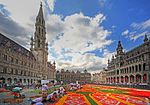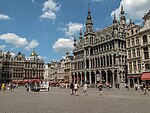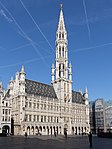Brussels City Museum

The Brussels City Museum (French: Musée de la ville de Bruxelles, Dutch: Museum van de Stad Brussel) is a museum on the Grand Place of Brussels, Belgium. It is dedicated to the history and folklore of the City of Brussels from its foundation to modern times, which it presents through paintings, sculptures, tapestries, engravings, photos and models, including a notable scale-representation of the town during the Middle Ages.Conceived in 1860 and inaugurated in 1887, the museum is situated opposite Brussels' Town Hall, in the Maison du Roi ("King's House") or Broodhuis ("Bread House" or "Bread Hall"). This building, in the Gothic Revival style, is listed as a UNESCO World Heritage Site, as part of the square.This site is served by the premetro (underground tram) station Bourse/Beurs (on lines 3 and 4), as well as the bus stop Grand Place/Grote Markt (on line 95).
Excerpt from the Wikipedia article Brussels City Museum (License: CC BY-SA 3.0, Authors, Images).Brussels City Museum
Grand Place, City of Brussels Pentagon (Brussels)
Geographical coordinates (GPS) Address Nearby Places Show on map
Geographical coordinates (GPS)
| Latitude | Longitude |
|---|---|
| N 50.846961 ° | E 4.35277 ° |
Address
Maison du Roi - Broodhuis
Grand Place 29
1000 City of Brussels, Pentagon (Brussels)
Belgium
Open on Google Maps











